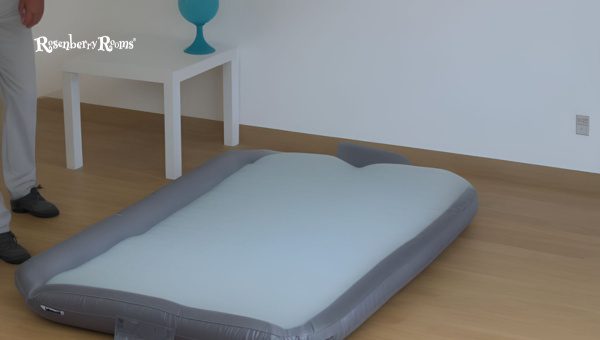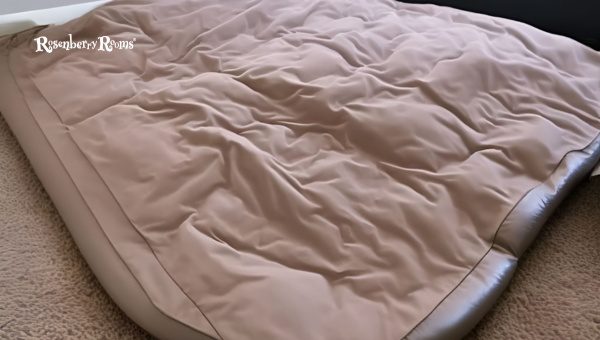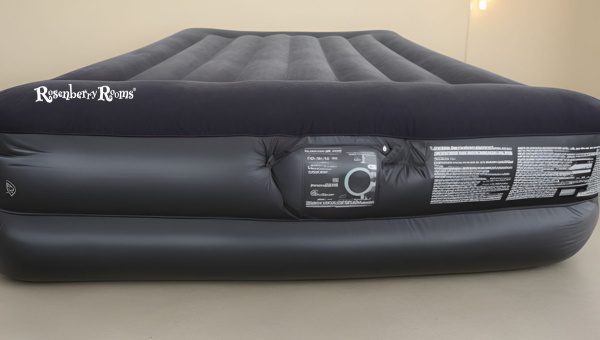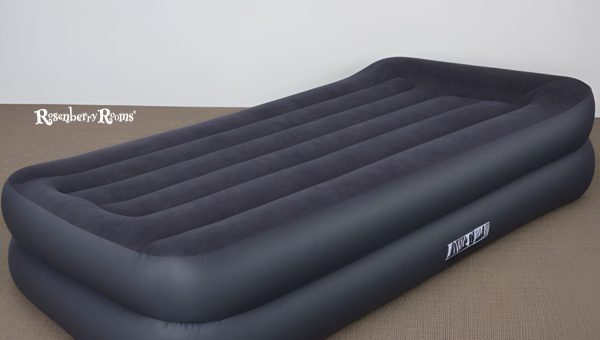Has your once air-tight and comfy air mattress started to feel like an old saggy couch? If you're tired of constantly refilling it, only to wake up in the middle of the night on a half-deflated balloon, then it's time to figure out why your air bed keeps losing air or deflates.
Don't fret! This isn't rocket science; we will provide helpful tips to troubleshoot the issue. Attention to key factors may bring your beloved air mattress back from its saggy pit of doom. So, stick around as we discuss the reasons behind your deflating problem and offer viable solutions.
Contents

Air bed mattress deflation is when an air mattress loses air, causing it to collapse or reduce size. This can occur for various reasons, including puncture, a loose valve, temperature changes, or simply age and regular usage, reducing the comfort and support the air bed provides.
Most air mattresses have an integrated pump that allows easy inflation and deflation. Still, in some cases, a separate pump may be needed to re-inflate a deflated air bed mattress.
The key culprit behind your air bed deflating may not be what you initially suspect. Even if your mattress is at the range and brand-new, it can still face losing air or deflation issues.

It's essential to understand why this happens to find proper solutions. Here are some specific reasons:
One of the possible reasons your air bed keeps losing air is due to changes in the room temperature. Air mattresses are filled with air, and the physical properties of air cause it to expand when heated and contract when cooled.
The air inside your mattress expands during warmer days or when central heating is turned on on the contrary, during cold nights or when an air-conditioned environment cools down a room greatly, this filling contracts, making your mattress appear to be losing air.
Also Read: How To Mix and Match Bedroom Furniture Like a Pro In 2025
Immediate use of an air bed after inflation can also potentially contribute to air loss. Inflatable beds need time to fully stretch out when they are new or haven't been used for a while. The material, typically vinyl or PVC, must expand and adjust to air filling.
When you inflate an air bed and immediately use it, the pressure combined with the stretching of the material can cause a slight decrease in firmness, which might seem like air loss.
It's often recommended to inflate new or long-unused air beds a few hours before their intended use and then top up with more air if necessary to prevent the illusion of deflation due to immediate use.
A small hole or several tiny holes could also be the reason behind your air bed losing air. Even a tiny puncture can result in significant air loss. This usually happens due to natural wear and tear or when the mattress comes into contact with sharp objects.
Over time, repeated inflation and deflation, as well as the weight it supports, can strain the material of the bed, possibly leading to minor tears or holes. If your mattress deflates quicker than normal, it might be worth checking for small holes.
Sitting or jumping on an air bed may also cause air loss. Air beds are designed for distributing weight evenly in a lying down position. When you sit or jump on it, more pressure is applied to a smaller surface area than when you lie down.
This increased pressure strains the seams and material of the bed, potentially causing tears or stretches that may result in air leakages. Even if no immediate tear occurs, this type of usage can lessen the lifespan of your air bed and gradually wear out its ability to hold air efficiently.
When not stored correctly, an air mattress is more susceptible to punctures and damage that can cause deflation. If the bed is stored while still inflated or partially inflated, pressure may build over time and induce leaks.
Also Read: 15 Best Under Bed Storage Ideas In 2025 [Space-Saving Overdrive]
Pet access can be another reason for your air bed losing air. The claws or teeth of pets can easily puncture or scratch the surface of an inflatable air bed, leading to small holes through which the mattress could slowly lose air.
If a pet climbs onto the mattress, their weight concentrated on their paws can also exert more pressure on specific points than human weight spread evenly, raising the chance for punctures.
A poor-quality air mattress might not be constructed well enough to withstand continuous inflation and deflation, nor the weight of users over time.
Low-quality materials can easily get punctured or torn, causing the bed to lose air more rapidly. The valves in such mattresses may also not be efficient in preventing air leaks.
Granting children unrestricted access to an air bed can also cause it to lose air. Due to their playful nature, children might jump or bounce on the air bed, increasing the pressure exerted on a specific area. This can result in air loss through weak points or cause leaks and punctures.
Children may inadvertently bring sharp objects onto the bed, potentially tearing the material and causing it to deflate.
Limit your child's unsupervised access to ensure your air bed lasts longer and to maintain its ability to stay inflated over time.
While a firm mattress can seem more comfortable, filling the bed with too much air puts extra pressure on the seams and material of the mattress.
This can weaken the bed's structure and create small tears or holes that allow air to escape. It may also stress the bed's valve system, reducing its ability to keep in the air effectively.
Yes, exceeding an air bed's weight limit can cause it to deflate. Every air mattress has a specified weight capacity; the excessive load can stress and strain the material when exceeded. This increases the risk of weakened areas, tears, or punctures through which air can escape.
Consistent overloading of the mattress can also impair its inner structure, causing the bed to lose firmness. Always be mindful of your air bed's manufacturer-stated weight limit and try not to exceed it to ensure longevity and proper air retention.

Waking up on a deflated air bed can be quite frustrating. Before discarding your trusty mattress, put on your detective cap! You might find the culprit behind the leak, and fixing it might be easier than you think. Here's how to go about it:
Firstly, you must confirm that your air bed is losing air rather than just shifting or adjusting to weight and temperature.
Inflate the mattress entirely and let it stand for a few hours untouched. If it seems noticeably deflated afterward, you've confirmed there must be a leak.
Now comes the challenging part - finding where your air bed is losing air. Inflate your air bed fully again, then start listening closely for a minute hissing sound - that's usually the tell-tale sign of an air leak.
Another method is running a soapy cloth along the inflated surface; bubbles will form due to escaping air if there's a leak.
Once you find the leak, cleaning the area around it before repairing it is essential. First, deflate your air mattress entirely.
Then, thoroughly clean that part of your mattress using a damp cloth or sponge to remove any dirt or grime. Use a tiny amount of mild detergent for stubborn stains, but avoid harsh chemicals that can damage the material.
After cleaning, let the area dry fully before moving onto the patching process – water and adhesive don't mix! Properly prepping your air bed this way significantly enhances the chances of a successful repair.
Also Read: 45 Small Living Room Ideas [Epic Hacks For Maximizing Space]
Most air mattresses have a patch kit designed to fix leaks or punctures. If you've pinpointed the leak and cleaned the area, you can cut a patch from this kit (if not pre-cut) to completely cover the hole, plus a little extra around it for good measure.
Apply the adhesive in the package onto the patch, place it over the hole, and press firmly over it. Let it dry for some time by the instructions on your repair kit.
If your air bed didn’t come with a patching kit or you don't have one handy, rubber cement can be a good alternative. You'll still need material to act as a patch - any air-tight tape or even an old piece of vinyl could suffice.
Just apply rubber cement on both surfaces (the inflatable mattress and your make-shift patch), let it become slightly tacky, and then stick them together, pressing down firmly. Again, allow plenty of time for drying before inflating your mattress again.
Seams are the most common places for leaks on an air bed due to the extra pressure they bear. Always take extra time to check seams when looking for leaks, and if you discover a tear or hole, carefully apply your patch to cover the hole and adhere well despite the raised seam.
If you're having trouble with this, it may be worth considering professional help, as improperly patched seams can cause additional problems later.
After your patch job is dry and set, inflate your air bed again, but not at full capacity. Check if your patch is holding up under pressure and keeping in the air as intended.
Look closely for any signs of bubbles formed around it when pressured - a sure sign that there's still some air leakage.
If you notice nothing amiss, inflate the mattress fully and give it time again to sit inflated. After some hours, if no deflation occurs, congratulations – you have successfully repaired your air bed.

An air bed can be a godsend, making overnight guests or camping trips much more comfortable. Despite the convenience, it’s common for these beds to spring a leak after some time.
However, with proper care and use, you can significantly extend the life of your air mattress, helping maintain its comfort and usability for many nights to come.
A mattress protector is one of the simplest ways to protect your air bed. These are covers slipped over the mattress, acting as the first line of defense against spills, stains, and everyday wear and tear.
They’re pretty easy to clean and take on most of the damage that would otherwise affect your bed directly. A quality protector will save your air bed from needless stress.
Admit it; we all love having our furry pals around us, but they might not be the best roommates for an air mattress!
Pet claws can easily puncture an air bed no matter how unintentional their movements might be. Keeping pets away from your air bed is crucial in maintaining its integrity. If that's not possible, consider investing in sturdy pet booties or nail covers - these will create peace between both parties!
An air bed is not a place for sharp objects such as keys, scissors, or eating utensils. One small puncture from these items can quickly deflate your comfort.
It’s always best to ensure you and your guests quickly check for potentially harmful objects before sprawling out on the air bed. An ounce of precaution can save you a pound of repair.
Routine is king here. Don’t just check for leaks when you sag into the floor at night; make it a habit to inspect your air mattress when in use regularly. Keep an ear out for hissing sounds or watch for slow deflation during the day, even when nobody uses it.
Regular checks will help catch a leak early before it significantly disrupts your sleep or becomes a more massive rip that’s harder to fix.
Proper inflation is critical to the lifespan of your air bed. Over-inflation can stress the material and seams, making them more likely to break or leak.
Always heed your pump's instructions; some pumps shut off automatically once a certain pressure is reached.
When deflating, open all valves to allow air out freely, preventing creases and folds that can weaken the material. The best practice is to inflate when needed and deflate when ready to pack away.
The cleanliness of your air bed is equally significant as its other protective measures. Regularly cleaning your air mattress keeps it smelling fresh and prevents damage from hard-to-remove stains or corrosive substances.
Use a mild soap solution and a soft cloth or sponge; never use harsh cleaning agents, as they could potentially damage the material. Rinse with warm water, then dry completely before packing away.
Also Read: How To Clean A Microfiber Couch [Freshen Up Every Kind Of Couch]
When you're not using your air bed, storage should be in a cool, dry place – moisture is an air mattress’s worst enemy.
Prolonged exposure to moist conditions may damage materials and encourage mold growth, which isn't only nasty but poses health risks.
Ensure the mattress is entirely dry before you roll or fold it for storage, as trapped moisture could result in unpleasant surprises the next time you unroll it for use.
Fluctuations in temperature, small holes or punctures, and even the user's weight can cause air mattresses to deflate over time.
Yes, a small amount of natural deflation can occur due to temperature changes and the weight applied to the mattress.
Patch kits are great for fixing small punctures or tears, but larger holes or damaged seams might require professional repair.
This could be due to "airbed stretch," a common occurrence where new vinyl components stretch out after the first few uses.
Overinflation puts unnecessary strain on your mattress’s seams and material, making them more prone to leaks.
Taking good care of an air bed is paramount to ensure you enjoy a good night's sleep without interruptions.
Regular maintenance, correct use, and responsible storage will significantly help preserve your mattress and make it last longer.
While deflation can be a common problem with air mattresses, understanding why it happens and how to prevent or fix it makes all the difference.
Invest in quality, treat it with respect, and your air mattress will reward you with countless nights of comfortable rest.